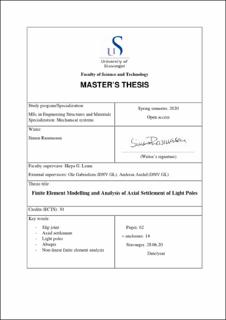Finite Element Modelling and Analysis of Axial Settlement of Light Poles
Master thesis
Permanent lenke
https://hdl.handle.net/11250/2679686Utgivelsesdato
2020Metadata
Vis full innførselSamlinger
Sammendrag
The slip joint technology is a method for connecting two conical pole segments together, without the use of bolts or grout, thus reducing time of installation and the need of maintenance. In recent years there have been an urge to apply this technology offshore, however there is generally little knowledge about its behavior. Furthermore, slip joint connections have been found to experience axial settlement over time. In this thesis detailed numerical analysis of the settlement phenomena of tall masts using slip joint connections has been performed.
The phenomenon has been studied by creating a light pole model, in finite element software Abaqus, which has been simulated with the full loading procedure consisting of pre-loading, upending and a series of storms, representing wind loads from several years of operation. Parameter studies has been performed where the influence of pre-load force and coefficient of friction on axial settlement have been analyzed.
Results showed that axial settlement occurred in the slip joint connection throughout the whole simulation procedure. With increased pre-load force, the slip joint connection experienced less axial settlement afterwards. Smaller coefficient of friction resulted in larger axial settlement both during pre-loading and afterwards. Therefore, it has been concluded that both pre-load force and the coefficient of friction affects the axial settlement in a slip joint connection.
Beskrivelse
Master's thesis in Engineering Structures
